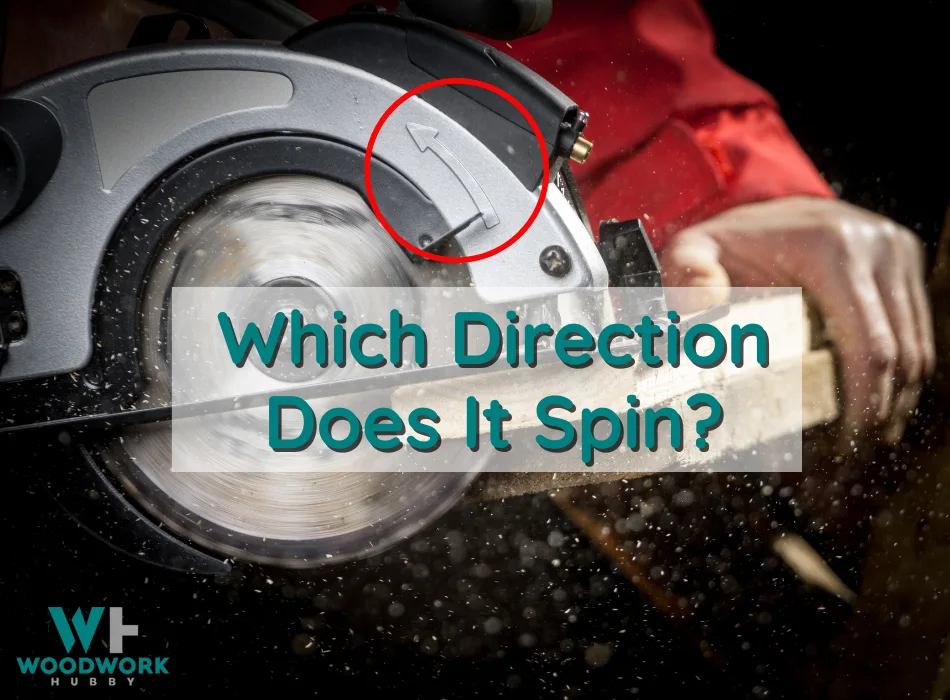If you’ve bought your first circular saw for a DIY project or even for professional use, the blade installation can be confusing. It seems like the blade might fit with the teeth facing up as well as down. But to position the blade and decide which way the wood should face, you must know which way the saw spins.
A circular saw spins with the teeth cutting in an upwards direction toward the base at the front of the saw. Most circular saw blades will have a label and will usually have arrows on them to show the direction of spin. Generally, most circular saws will also have a marking on the guard showing the direction of the blade.
In this article, I will cover circular saw spinning, blade installation, and what you must do to make sure your woodworking project gets the most out of a circular saw. This includes more details regarding the saw rotation and its exceptions, the teeth placement, and whether you can reverse the blade.
Which Direction Does a Circular Saw Rotate?
Circular Saw Spin Direction
A circular saw will rotate upwards with the teeth moving in an upward motion.
Some people may tell you that the blade rotates in a clockwise direction. This is only true if looking at the saw or the blade from the right side.
Below is a picture of one of my circular saws. This is very typical of how most saws look. You can see from this image, the blade rotates upwards which is actually rotating anti-clockwise in this picture.
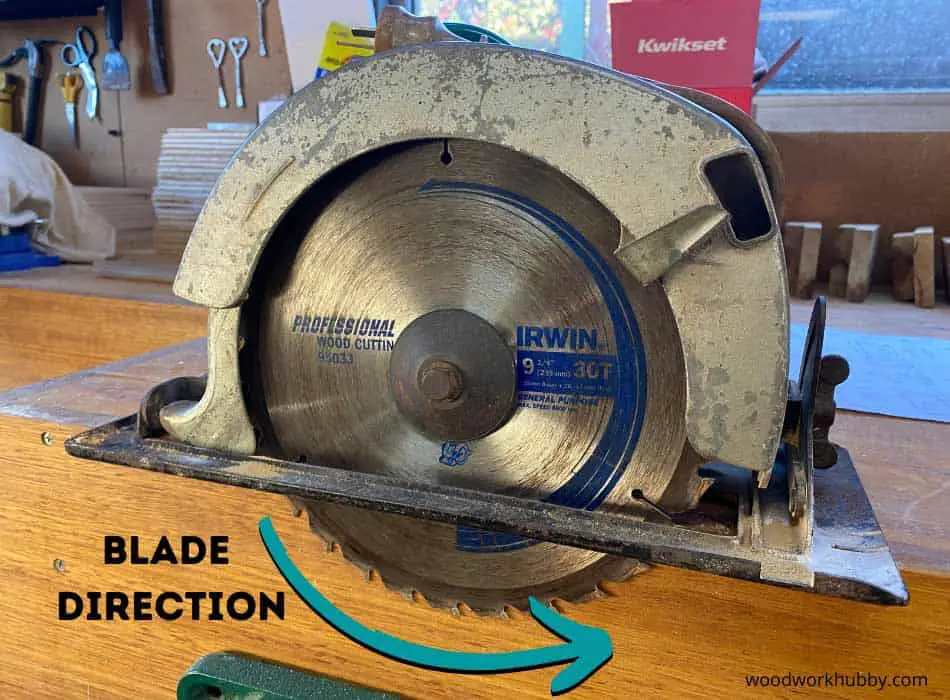
Why Does A Circular Saw Blade Spin Upwards?
A circular saw blade spins upwards as it forces the wood to be held between the blade and the base of the circular saw.
If the blade was to spin downwards, the saw teeth would grab in the wood and throw your saw up out of the cut. This would be particularly dangerous and hard to control.
I guess the problem I have found with a circular saw cutting upwards, is it tends to throw sawdust up in the user’s face. Most saws combat this with well-built guards but eye protection is a must!
Which Way Should Teeth Face On Circular Saw?
The teeth on your circular saw blade should point in an upward direction at the front of the saw. The teeth will cut upwards through the wood when using a circular saw.
Do All Circular Saws Rotate In The Same Direction?
All circular saw blades spin in an upward direction with the teeth pointing up towards the base of the saw. This is the only safe way to cut wood.
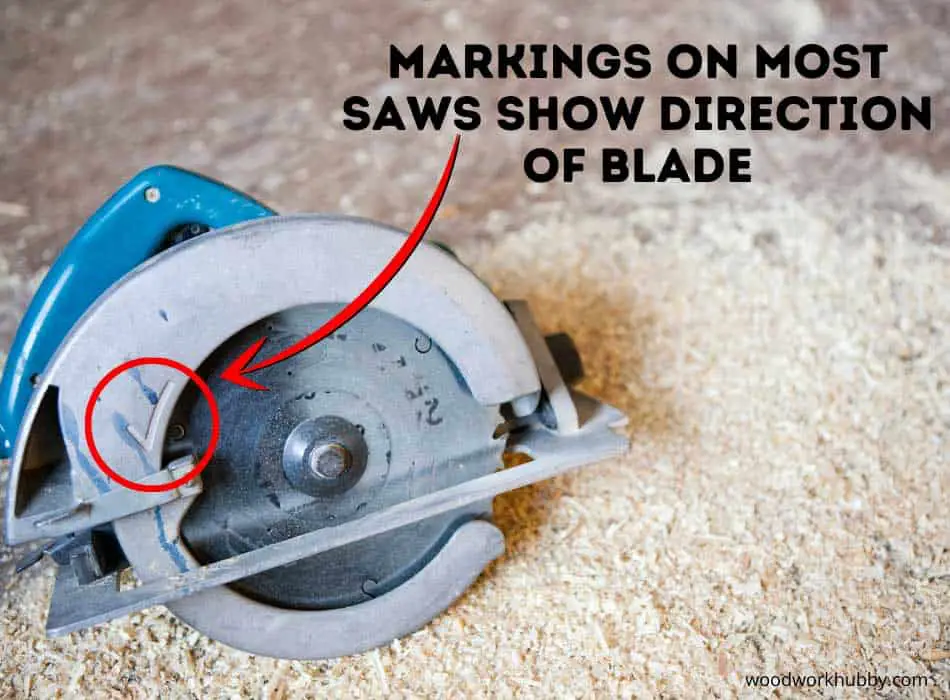
If the blade was to spin downwards away from the base of the saw, the teeth would grab the wood & throw the saw out of the cut!
Circular Saw Blade Rotation
The blade rotation of a circular saw is upwards into the cut or the base of the front of the saw.
I can’t say it’s clockwise or anti-clockwise as that would depend entirely on which way you were looking at the saw. The photos I share in this article certainly tell it all.
Which Way Should Teeth Face in a Table Saw/Miter Saw?
Now that you know how to get the perfect cut with a circular saw let’s look at saws that enable even more precision with the right support and mounting mechanisms.
These are mainly the miter saw, and the table saw, both that leverage fixed block placement and mounted saw for better precision. However, placing the blade with its teeth facing the wrong way can wreak havoc on the blade and the block.
The teeth should face downwards in a table saw as well as a miter saw as this enables their blades’ clockwise rotation to make the maximum impact on wood without incurring parallel motion inefficiency.
At the same time, making sure the wood is stable and the markings on the table or the platform underneath are positioned appropriately will help avoid rough, unintended cuts and scratches on the piece you’re working on.
For more precise cutting with a miter saw, you’ll also need to consider the following.
Make sure the material is clamped down. Depending on your arm motion and the saw placement, the blade will pull the material towards you or push it away. If the workpiece isn’t heavy enough, clamping it down can keep the piece from moving mid-cut
A table saw is just like an upside-down circular saw!
Wear Protective Gear
Interestingly, having well-protected hands also helps with precision as you’re not as nervous anymore and are willing to pay more attention to the blade placement. Keeping your hand, regardless of how sheathed they are, away from the blade by at least six inches is highly recommended.
Tune-up Your Saw
Whether due to previous woodworking or by rough shipping, your miter saw might have come out of sync and may not be “factory-tuned.” Tune your saw by ensuring that the blade is square to the table.
Most people get this instinctively and often fix their blade adjustments to match. However, you also need to make sure that the fence is square to the table, or you’ll end up wondering why your cuts are crooked.
While most of the above also applies to table saws, there are a few functional differences that lead to slightly different, additional prescriptions for precision for table saws. For more precise cutting with a table saw, you’ll also need to consider the following.
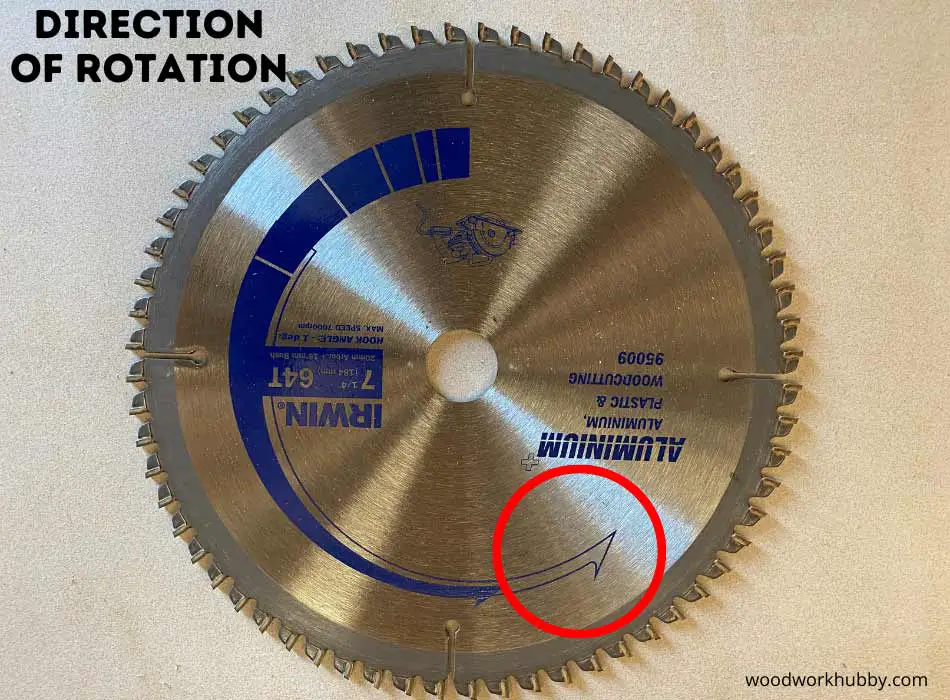
Use Feather Boards to Hold the Wood Straight
While clamps work for table saws as well, the elongated sawing motion allows you to use feather boards at an angle to act as an extra pair of hands.
Use Push Sticks to Feed Wood to the Saw
Just like withholding the saw an appropriate distance away from the blade with a miter saw, you need to protect your hands to be able to focus on the lumber instead of being too nervous to care about precise cutting.
Use Fixed Support From Multiple Angles
The worst thing you can do for a project’s accuracy is to shove blocks of wood with a single hand. That’s because the more fixed guiding positions there are behind and around the block, the more stable it is when it meets the blade.
That’s why it is recommended to use a half fence with complicated grain and multiple support points on the side with a thicker block. Whether you’re using a miter saw or a table saw, precision hacks are only cosmetic touch-ups that cannot offset the need for a sharp blade made of high-quality material.
More importantly, the blade must be installed right, so it doesn’t dislodge from the saw and become a projectile. Getting the blade placement right (including the direction) is therefore critical for your project’s success.
Are All Saws The Same?
You may have noticed a common theme here. It doesn’t matter if you have a circular saw, table saw or miter saw, all saw blades will try to pull the wood towards a fixed base or fence while cutting it. This means maximum control is maintained at all times.
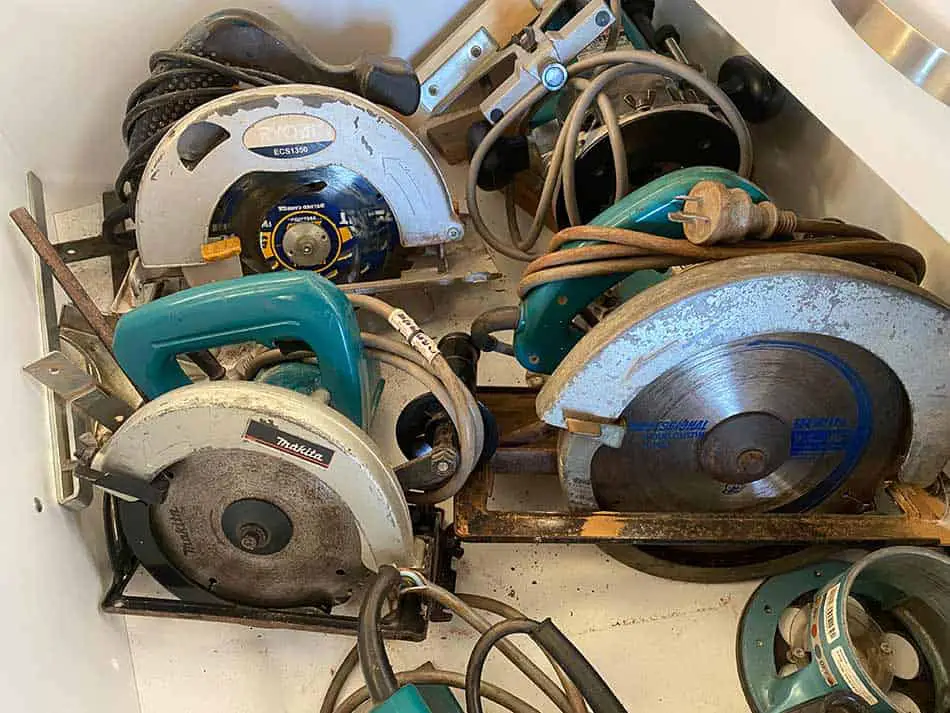
Skill Saw Blade Direction
The blade on a Skill Saw should be installed facing the same as any other circular saw. The teeth should cut upward into the base at the front of the saw.
Skill Saw Blade direction is generally marked on the guard of the saw.
Can You Put A Circular Saw on Backwards?
A circular saw blade can be put on backward but should never be done!
When it comes to blade placement, circular saws are no different from miter saws and table saws. Getting the circular blade in the saw the right way up is critical to operations, and if you don’t do it right, you will have one very dangerous tool in your hands.
A blade backward will try to pull your saw through the wood which is very dangerous. ALWAYS make sure the teeth are pointing upwards.
Are Circular Saw Nuts Reverse Threaded?
The nut on a circular saw always tightens in the opposite direction of the saw blade’s rotation or direction of spin.
If the nut tightened in the same direction as the blade spins, the nut would always undo itself.
How To Change A Circular Saw Blade?
These are the steps I take to change a circular saw blade:
Conclusion – Which Way Does a Circular Saw Spin?
As you have seen, a circular saw blade will always spin with the teeth pointing upwards towards the base of the saw at the front.
FAQ
1. Which Way Should The Teeth Be Facing On a Circular Saw Blade? How Is This Determined?
The teeth on a circular saw should be facing so that the teeth are cutting in an upwards direction toward the base at the front of the saw.
2. What Way Should The Teeth Face On a Skill Saw?
The teeth on a Skill saw should cut upward into the cut. This will mean if you are looking at the blade with the front of the saw pointing left, the blade should spin in a clockwise direction.
If you are looking at the blade with the front of the saw pointing right, the blade should spin in an anti-clockwise direction.
3. Why Do Circular/Skill Saws Have The Blade Turn So That It Cuts Upward (Counter Clockwise) Rather Than Downward (Clockwise)?
If the blade was to spin downwards when cutting, the saw blade’s teeth would grab the wood and try to push the saw up out of the wood. This would be extremely dangerous.
By cutting upward, the wood is held by the base of the saw and enables the teeth to cut it rather than throwing the wood up.

